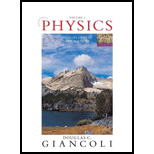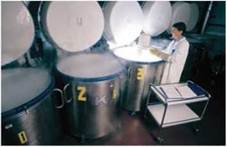
Physics: Principles and Applications -- Pearson e Text Instant Access (Pearson+)
7th Edition
ISBN: 9780137679065
Author: Douglas Giancoli
Publisher: PEARSON+
expand_more
expand_more
format_list_bulleted
Textbook Question
Chapter 15, Problem 22P
A

Figure 15-25
Expert Solution & Answer
Want to see the full answer?
Check out a sample textbook solution
Students have asked these similar questions
Part A
m
2πkT
) 3/2
Calculate the integral (v) = f vƒ (v)dv. The function f(v) describing the actual distribution of molecular speeds is called the Maxwell-Boltzmann distribution,
=
ƒ(v) = 4π (· v²e-mv²/2kT
. (Hint: Make the change of variable v² =x and use the tabulated integral foxne
integer and a is a positive constant.)
Express your answer in terms of the variables T, m, and appropriate constants.
-ax dx
n!
-
an+1
where n is a positive
(v)
=
ΕΠΙ ΑΣΦ
Submit Previous Answers Request Answer
?
× Incorrect; Try Again; 4 attempts remaining
Al Study Tools
Looking for some guidance? Let's work through a few related
practice questions before you go back to the real thing.
This won't impact your score, so stop at anytime and ask for
clarification whenever you need it.
Ready to give it a try?
Start
Starter the rule of significant
Please solve this problem and give step by step explanations on each step while breaking it down please. Thank you!!
Chapter 15 Solutions
Physics: Principles and Applications -- Pearson e Text Instant Access (Pearson+)
Ch. 15 - Prob. 1OQCh. 15 - hi an isothermal process, 3700 J of work is done...Ch. 15 - Prob. 2QCh. 15 - Prob. 3QCh. 15 - Prob. 4QCh. 15 - An ideal monatomic gas expands slowly to twice its...Ch. 15 - Prob. 6QCh. 15 - Prob. 7QCh. 15 - What are the high-temperature and the...Ch. 15 - Prob. 9Q
Ch. 15 - Prob. 10QCh. 15 - Prob. 11QCh. 15 - Prob. 12QCh. 15 - Prob. 13QCh. 15 - Prob. 14QCh. 15 - Prob. 15QCh. 15 - Prob. 16QCh. 15 - Prob. 17QCh. 15 - Prob. 18QCh. 15 - Prob. 19QCh. 15 - Prob. 20QCh. 15 - Prob. 1MCQCh. 15 - Prob. 2MCQCh. 15 - Prob. 3MCQCh. 15 - Prob. 4MCQCh. 15 - Prob. 5MCQCh. 15 - Prob. 6MCQCh. 15 - Prob. 7MCQCh. 15 - Prob. 8MCQCh. 15 - Prob. 9MCQCh. 15 - Prob. 10MCQCh. 15 - Prob. 11MCQCh. 15 - An ideal gas expands isothermally, performing 4.30...Ch. 15 - Prob. 2PCh. 15 - Prob. 3PCh. 15 - Prob. 4PCh. 15 - A 10-L volume of air initially at 3.5 atm of...Ch. 15 - Prob. 6PCh. 15 - Prob. 7PCh. 15 - Prob. 8PCh. 15 - Prob. 9PCh. 15 - Consider the following two-step process. Heat is...Ch. 15 - Prob. 11PCh. 15 - 12. (Ill) The PV diagram in Fig. 15-23 (? shows...Ch. 15 - Prob. 13PCh. 15 - Prob. 14PCh. 15 - Prob. 15PCh. 15 - Prob. 16PCh. 15 - (a) How much energy is transformed by a typical...Ch. 15 - A heat engine exhausts 8200 J of heat while...Ch. 15 - What is the maximum efficiency of a heat engine...Ch. 15 - The exhaust temperature of a heat engine is 230°C....Ch. 15 - Prob. 21PCh. 15 - A heat engine's high temperature T„ could be...Ch. 15 - Which will Improve the efficiency of a Carnot...Ch. 15 - Prob. 24PCh. 15 - Prob. 25PCh. 15 - Prob. 26PCh. 15 - Prob. 27PCh. 15 - Prob. 28PCh. 15 - Prob. 29PCh. 15 - A heat engine uses a heat source at580°Cand has an...Ch. 15 - A typical compact car experiences a total drag...Ch. 15 - If an ideal refrigerator keeps its contents at...Ch. 15 - Prob. 33PCh. 15 - Prob. 34PCh. 15 - Prob. 35PCh. 15 - Prob. 36PCh. 15 - Prob. 37PCh. 15 - Prob. 38PCh. 15 - Prob. 39PCh. 15 - Prob. 40PCh. 15 - What is the change in entropy of 1.00 m3of water...Ch. 15 - Prob. 42PCh. 15 - Prob. 43PCh. 15 - Prob. 44PCh. 15 - Prob. 45PCh. 15 - Prob. 46PCh. 15 - Prob. 47PCh. 15 - Prob. 48PCh. 15 - Prob. 49PCh. 15 - Suppose that you repeatedly shake six coins in...Ch. 15 - Prob. 51PCh. 15 - Prob. 52PCh. 15 - Prob. 53PCh. 15 - Prob. 54PCh. 15 - Prob. 55PCh. 15 - Prob. 56GPCh. 15 - When 5.80 x 105J of heat is added to a gas...Ch. 15 - Prob. 58GPCh. 15 - Prob. 59GPCh. 15 - Prob. 60GPCh. 15 - Prob. 61GPCh. 15 - Prob. 62GPCh. 15 - Prob. 63GPCh. 15 - Prob. 64GPCh. 15 - Prob. 65GPCh. 15 - The burning of gasoline in a car releases about...Ch. 15 - Prob. 67GPCh. 15 - Calculate the work done by an ideal gas in going...Ch. 15 - Prob. 69GPCh. 15 - Suppose a power plant delivers energy at 880 MW...Ch. 15 - Prob. 71GPCh. 15 - Prob. 72GPCh. 15 - Prob. 73GPCh. 15 - Prob. 74GPCh. 15 - Prob. 75GPCh. 15 - Prob. 76GPCh. 15 - Prob. 77GP
Knowledge Booster
Learn more about
Need a deep-dive on the concept behind this application? Look no further. Learn more about this topic, physics and related others by exploring similar questions and additional content below.Similar questions
- Car A starts from rest at t = 0 and travels along a straight road with a constant acceleration of 6 ft/s^2 until it reaches a speed of 60ft/s. Afterwards it maintains the speed. Also, when t = 0, car B located 6000 ft down the road is traveling towards A at a constant speed of 80 ft/s. Determine the distance traveled by Car A when they pass each other.Write the solution using pen and draw the graph if needed.arrow_forwardIn the given circuit the charge on the plates of 1 μF capacitor, when 100 V battery is connected to the terminals A and B, will be 2 μF A 1 µF B 3 µFarrow_forwardThe velocity of a particle moves along the x-axis and is given by the equation ds/dt = 40 - 3t^2 m/s. Calculate the acceleration at time t=2 s and t=4 s. Calculate also the total displacement at the given interval. Assume at t=0 s=5m.Write the solution using pen and draw the graph if needed.arrow_forward
- The velocity of a particle moves along the x-axis and is given by the equation ds/dt = 40 - 3t^2 m/s. Calculate the acceleration at time t=2 s and t=4 s. Calculate also the total displacement at the given interval. Assume at t=0 s=5m.Write the solution using pen and draw the graph if needed.arrow_forwardThe velocity of a particle moves along the x-axis and is given by the equation ds/dt = 40 - 3t^2 m/s. Calculate the acceleration at time t=2 s and t=4 s. Calculate also the total displacement at the given interval. Assume at t=0 s=5m.Write the solution using pen and draw the graph if needed. NOT AI PLSarrow_forwardThe velocity of a particle moves along the x-axis and is given by the equation ds/dt = 40 - 3t^2 m/s. Calculate the acceleration at time t=2 s and t=4 s. Calculate also the total displacement at the given interval. Assume at t=0 s=5m.Write the solution using pen and draw the graph if needed.arrow_forward
- The velocity of a particle moves along the x-axis and is given by the equation ds/dt = 40 - 3t^2 m/s. Calculate the acceleration at time t=2 s and t=4 s. Calculate also the total displacement at the given interval. Assume at t=0 s=5m.Write the solution using pen and draw the graph if needed.arrow_forwardPlease don't use Chatgpt will upvote and give handwritten solutionarrow_forwardNo chatgpt pls will upvote Already got wrong chatgpt answerarrow_forward
arrow_back_ios
SEE MORE QUESTIONS
arrow_forward_ios
Recommended textbooks for you

 Physics for Scientists and Engineers: Foundations...PhysicsISBN:9781133939146Author:Katz, Debora M.Publisher:Cengage Learning
Physics for Scientists and Engineers: Foundations...PhysicsISBN:9781133939146Author:Katz, Debora M.Publisher:Cengage Learning Physics for Scientists and Engineers, Technology ...PhysicsISBN:9781305116399Author:Raymond A. Serway, John W. JewettPublisher:Cengage Learning
Physics for Scientists and Engineers, Technology ...PhysicsISBN:9781305116399Author:Raymond A. Serway, John W. JewettPublisher:Cengage Learning Principles of Physics: A Calculus-Based TextPhysicsISBN:9781133104261Author:Raymond A. Serway, John W. JewettPublisher:Cengage Learning
Principles of Physics: A Calculus-Based TextPhysicsISBN:9781133104261Author:Raymond A. Serway, John W. JewettPublisher:Cengage Learning College PhysicsPhysicsISBN:9781285737027Author:Raymond A. Serway, Chris VuillePublisher:Cengage Learning
College PhysicsPhysicsISBN:9781285737027Author:Raymond A. Serway, Chris VuillePublisher:Cengage Learning College PhysicsPhysicsISBN:9781305952300Author:Raymond A. Serway, Chris VuillePublisher:Cengage Learning
College PhysicsPhysicsISBN:9781305952300Author:Raymond A. Serway, Chris VuillePublisher:Cengage Learning


Physics for Scientists and Engineers: Foundations...
Physics
ISBN:9781133939146
Author:Katz, Debora M.
Publisher:Cengage Learning

Physics for Scientists and Engineers, Technology ...
Physics
ISBN:9781305116399
Author:Raymond A. Serway, John W. Jewett
Publisher:Cengage Learning

Principles of Physics: A Calculus-Based Text
Physics
ISBN:9781133104261
Author:Raymond A. Serway, John W. Jewett
Publisher:Cengage Learning

College Physics
Physics
ISBN:9781285737027
Author:Raymond A. Serway, Chris Vuille
Publisher:Cengage Learning

College Physics
Physics
ISBN:9781305952300
Author:Raymond A. Serway, Chris Vuille
Publisher:Cengage Learning
The Second Law of Thermodynamics: Heat Flow, Entropy, and Microstates; Author: Professor Dave Explains;https://www.youtube.com/watch?v=MrwW4w2nAMc;License: Standard YouTube License, CC-BY